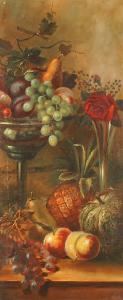 CHURCH, HENRY, JR.
CHURCH, HENRY, JR.
(1836–1908)
was an Ohio blacksmith, musician, woodsman, self-taught painter, and sculptor. Born in Chagrin Falls, Ohio, a new settlement on the Western Reserve, the artistacquired as a boy attitudes that were to inform his adult work. Judged too sickly to attend school, he roamed the woods, developing a sense of autonomy, a love of nature, and respect for Native American traditions. Apprenticed at thirteen in his father’s blacksmith shop, the young man learned his trade well, but the work did notsatisfy his intellectual or artistic yearnings. Among the ideas he explored was spiritualism and its belief that the spirits of the dead are accessible to the living.Through painting and sculpture Church gave his philosophical notions material form. On a massive block of sandstone jutting into a river, he carved a NativeAmerican woman surrounded by symbols of the American state and Iroquois artifacts. Beneath her is a skeleton. He called the work
Rape of the Indians by theWhite Man
(1885), and preached to the spirits of the Indians from a pulpit on the riverbank. Living in harmony with nature and at peace with one’s neighbors are other themes that recur in Church’s work. Intended as a monument for the village square but rejected by the town fathers,
The Lion and Fatling Together
(1888) is a largesandstone sculpture, based on the verse in Isaiah 11:6. Another sculpture,
A Friend in Need Is a Friend Indeed
(1885), shows a sheepdog fearlessly attacking a wildanimal that threatens his master. In Church’s hands Benjamin Franklin’s cynical aphorism becomes a statement about loyalty. Animals are also featured in many of Church’s paintings. Best known is
The Monkey Picture
(c. 1885–1890), a spoof of a still-life painting in which two monkeys escape their cage and run amok on astaid Victorian dining table as a policeman, bent on corralling them, appears in the doorway.Church taught himself to paint by reading manuals, copying works of established artists, and experimenting with a variety of media. He showed considerable resourcefulness, if little success, in attempting to generate income as an artist, and he continued to do so until his death. Church achieved only local renown during hislifetime.
See also
Painting, American Folk; Sculpture, Folk;
Visionary Art
.
BIBLIOGRAPHY
Babinsky, Jane E., and Miriam C.Stem.
The Life and Work of Henry Church, Jr.
Chagrin Falls, Ohio, 1984.Lipman, Jean, and Tom Armstrong, eds.
American Folk Painters of Three Centuries.
New York, 1980.Robinson, William C., and David Steinberg.
Transformations in Cleveland Art, 1796–1946.
Cleveland, Ohio, 1996.Studer, Carol Millsom, and Victor Studer. “Henry Church Jr.,” in
SelfTaught Artists of the Twentieth Century: An American Anthology,
edited by Elsa Longhauser, etal. New York: Museum of American Folk Art, 1998
